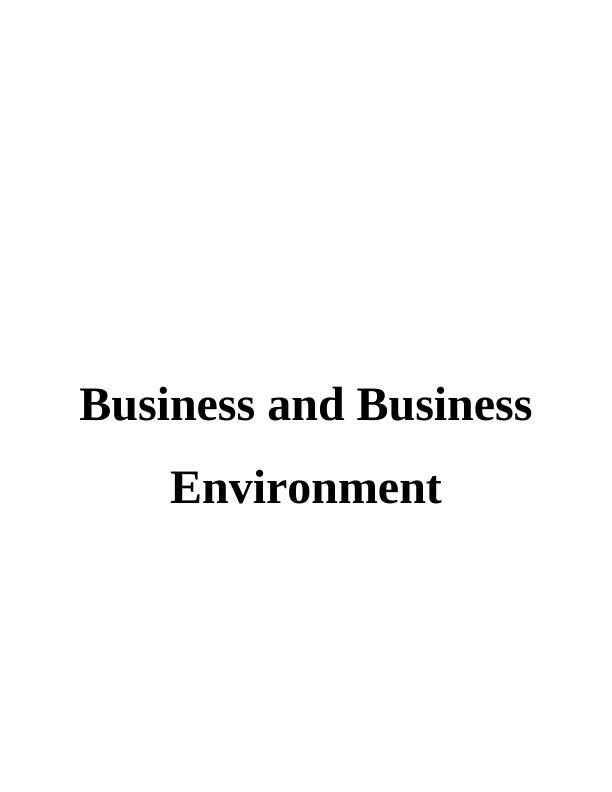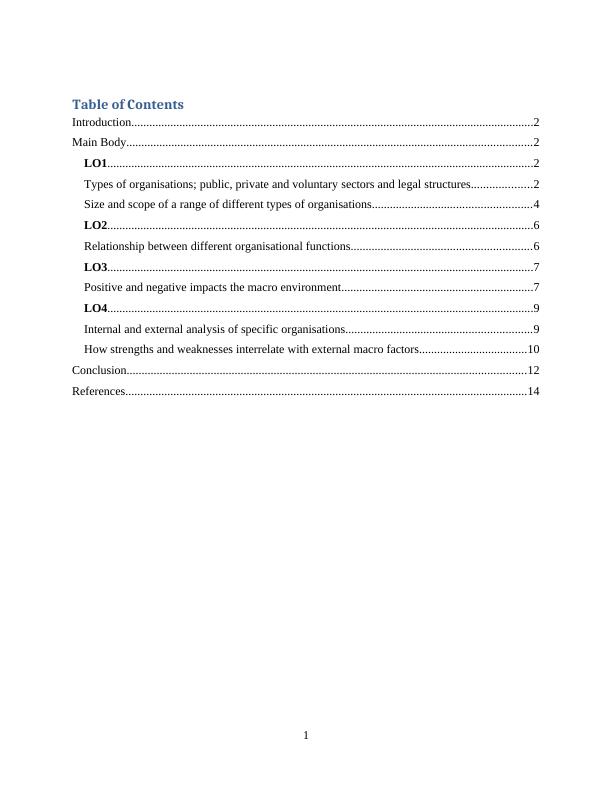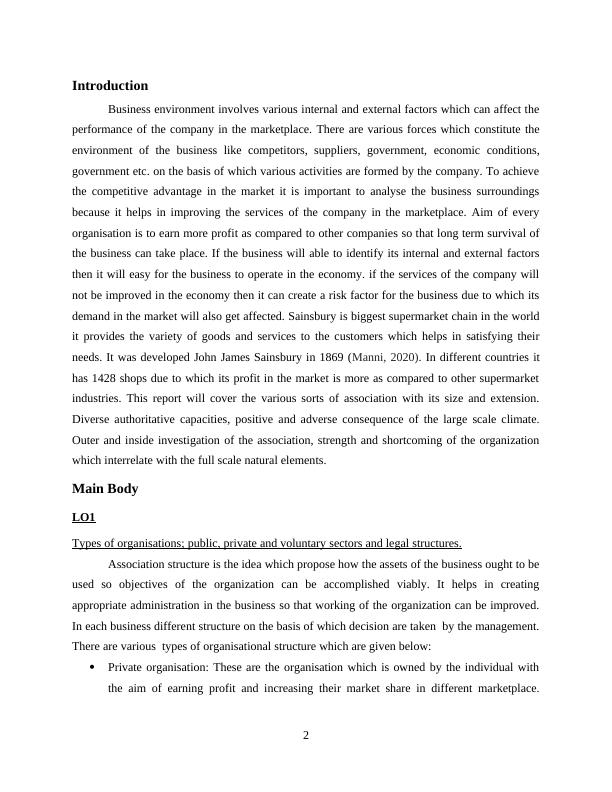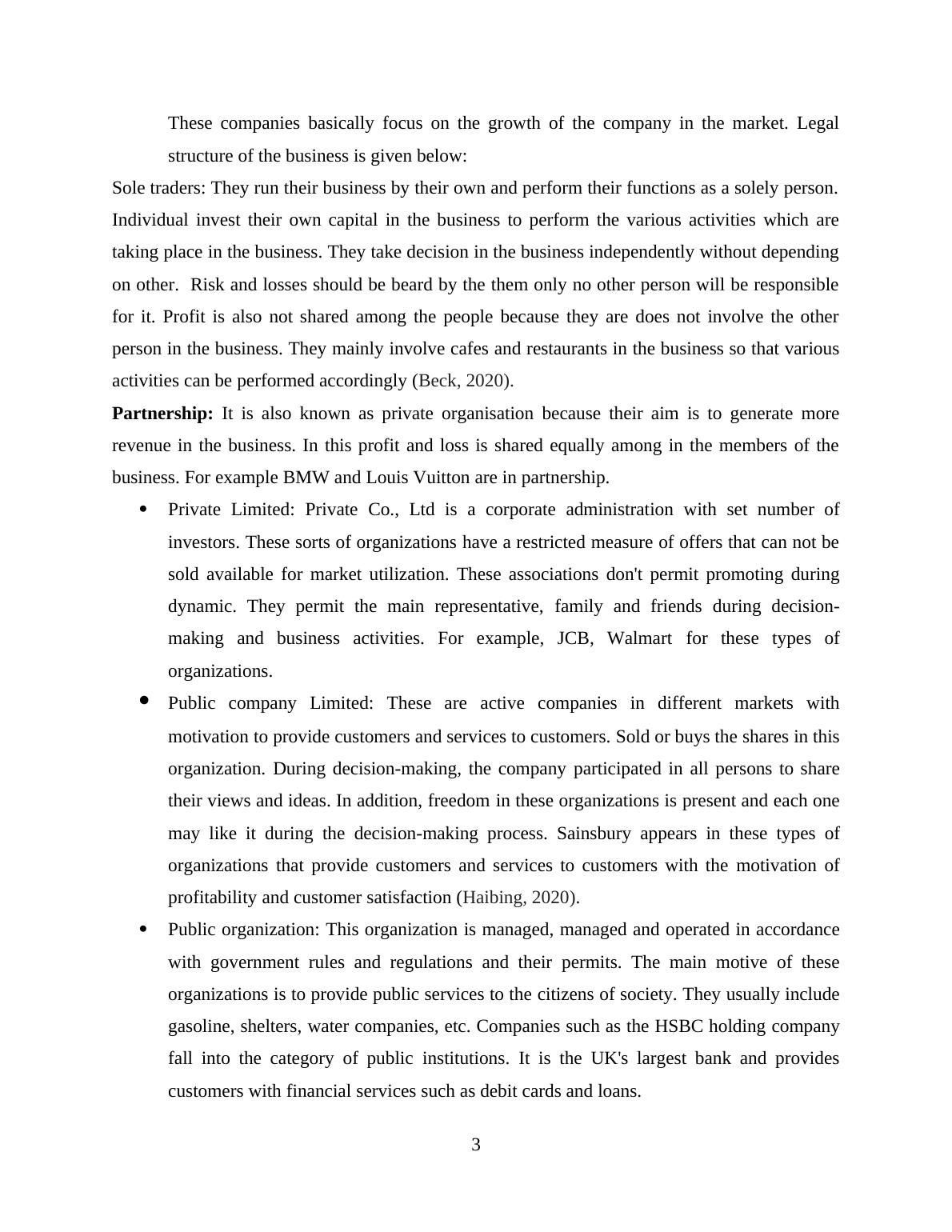Types of organisations and their functions
16 Pages5478 Words400 Views
Added on 2022-11-24
About This Document
This document discusses the types of organisations, including public, private, and voluntary sectors, and their legal structures. It also explores the relationship between different organisational functions such as marketing, HR, finance, sales, and IT. Additionally, it covers the size and scope of various organisations and how they impact their operations. The case study of Sainsbury is used to illustrate these concepts.
Types of organisations and their functions
Added on 2022-11-24
ShareRelated Documents
Business and Business
Environment
Environment

Table of Contents
Introduction......................................................................................................................................2
Main Body.......................................................................................................................................2
LO1..............................................................................................................................................2
Types of organisations; public, private and voluntary sectors and legal structures....................2
Size and scope of a range of different types of organisations.....................................................4
LO2..............................................................................................................................................6
Relationship between different organisational functions............................................................6
LO3..............................................................................................................................................7
Positive and negative impacts the macro environment................................................................7
LO4..............................................................................................................................................9
Internal and external analysis of specific organisations..............................................................9
How strengths and weaknesses interrelate with external macro factors....................................10
Conclusion.....................................................................................................................................12
References......................................................................................................................................14
1
Introduction......................................................................................................................................2
Main Body.......................................................................................................................................2
LO1..............................................................................................................................................2
Types of organisations; public, private and voluntary sectors and legal structures....................2
Size and scope of a range of different types of organisations.....................................................4
LO2..............................................................................................................................................6
Relationship between different organisational functions............................................................6
LO3..............................................................................................................................................7
Positive and negative impacts the macro environment................................................................7
LO4..............................................................................................................................................9
Internal and external analysis of specific organisations..............................................................9
How strengths and weaknesses interrelate with external macro factors....................................10
Conclusion.....................................................................................................................................12
References......................................................................................................................................14
1

Introduction
Business environment involves various internal and external factors which can affect the
performance of the company in the marketplace. There are various forces which constitute the
environment of the business like competitors, suppliers, government, economic conditions,
government etc. on the basis of which various activities are formed by the company. To achieve
the competitive advantage in the market it is important to analyse the business surroundings
because it helps in improving the services of the company in the marketplace. Aim of every
organisation is to earn more profit as compared to other companies so that long term survival of
the business can take place. If the business will able to identify its internal and external factors
then it will easy for the business to operate in the economy. if the services of the company will
not be improved in the economy then it can create a risk factor for the business due to which its
demand in the market will also get affected. Sainsbury is biggest supermarket chain in the world
it provides the variety of goods and services to the customers which helps in satisfying their
needs. It was developed John James Sainsbury in 1869 (Manni, 2020). In different countries it
has 1428 shops due to which its profit in the market is more as compared to other supermarket
industries. This report will cover the various sorts of association with its size and extension.
Diverse authoritative capacities, positive and adverse consequence of the large scale climate.
Outer and inside investigation of the association, strength and shortcoming of the organization
which interrelate with the full scale natural elements.
Main Body
LO1
Types of organisations; public, private and voluntary sectors and legal structures.
Association structure is the idea which propose how the assets of the business ought to be
used so objectives of the organization can be accomplished viably. It helps in creating
appropriate administration in the business so that working of the organization can be improved.
In each business different structure on the basis of which decision are taken by the management.
There are various types of organisational structure which are given below:
Private organisation: These are the organisation which is owned by the individual with
the aim of earning profit and increasing their market share in different marketplace.
2
Business environment involves various internal and external factors which can affect the
performance of the company in the marketplace. There are various forces which constitute the
environment of the business like competitors, suppliers, government, economic conditions,
government etc. on the basis of which various activities are formed by the company. To achieve
the competitive advantage in the market it is important to analyse the business surroundings
because it helps in improving the services of the company in the marketplace. Aim of every
organisation is to earn more profit as compared to other companies so that long term survival of
the business can take place. If the business will able to identify its internal and external factors
then it will easy for the business to operate in the economy. if the services of the company will
not be improved in the economy then it can create a risk factor for the business due to which its
demand in the market will also get affected. Sainsbury is biggest supermarket chain in the world
it provides the variety of goods and services to the customers which helps in satisfying their
needs. It was developed John James Sainsbury in 1869 (Manni, 2020). In different countries it
has 1428 shops due to which its profit in the market is more as compared to other supermarket
industries. This report will cover the various sorts of association with its size and extension.
Diverse authoritative capacities, positive and adverse consequence of the large scale climate.
Outer and inside investigation of the association, strength and shortcoming of the organization
which interrelate with the full scale natural elements.
Main Body
LO1
Types of organisations; public, private and voluntary sectors and legal structures.
Association structure is the idea which propose how the assets of the business ought to be
used so objectives of the organization can be accomplished viably. It helps in creating
appropriate administration in the business so that working of the organization can be improved.
In each business different structure on the basis of which decision are taken by the management.
There are various types of organisational structure which are given below:
Private organisation: These are the organisation which is owned by the individual with
the aim of earning profit and increasing their market share in different marketplace.
2

These companies basically focus on the growth of the company in the market. Legal
structure of the business is given below:
Sole traders: They run their business by their own and perform their functions as a solely person.
Individual invest their own capital in the business to perform the various activities which are
taking place in the business. They take decision in the business independently without depending
on other. Risk and losses should be beard by the them only no other person will be responsible
for it. Profit is also not shared among the people because they are does not involve the other
person in the business. They mainly involve cafes and restaurants in the business so that various
activities can be performed accordingly (Beck, 2020).
Partnership: It is also known as private organisation because their aim is to generate more
revenue in the business. In this profit and loss is shared equally among in the members of the
business. For example BMW and Louis Vuitton are in partnership.
Private Limited: Private Co., Ltd is a corporate administration with set number of
investors. These sorts of organizations have a restricted measure of offers that can not be
sold available for market utilization. These associations don't permit promoting during
dynamic. They permit the main representative, family and friends during decision-
making and business activities. For example, JCB, Walmart for these types of
organizations.
Public company Limited: These are active companies in different markets with
motivation to provide customers and services to customers. Sold or buys the shares in this
organization. During decision-making, the company participated in all persons to share
their views and ideas. In addition, freedom in these organizations is present and each one
may like it during the decision-making process. Sainsbury appears in these types of
organizations that provide customers and services to customers with the motivation of
profitability and customer satisfaction (Haibing, 2020).
Public organization: This organization is managed, managed and operated in accordance
with government rules and regulations and their permits. The main motive of these
organizations is to provide public services to the citizens of society. They usually include
gasoline, shelters, water companies, etc. Companies such as the HSBC holding company
fall into the category of public institutions. It is the UK's largest bank and provides
customers with financial services such as debit cards and loans.
3
structure of the business is given below:
Sole traders: They run their business by their own and perform their functions as a solely person.
Individual invest their own capital in the business to perform the various activities which are
taking place in the business. They take decision in the business independently without depending
on other. Risk and losses should be beard by the them only no other person will be responsible
for it. Profit is also not shared among the people because they are does not involve the other
person in the business. They mainly involve cafes and restaurants in the business so that various
activities can be performed accordingly (Beck, 2020).
Partnership: It is also known as private organisation because their aim is to generate more
revenue in the business. In this profit and loss is shared equally among in the members of the
business. For example BMW and Louis Vuitton are in partnership.
Private Limited: Private Co., Ltd is a corporate administration with set number of
investors. These sorts of organizations have a restricted measure of offers that can not be
sold available for market utilization. These associations don't permit promoting during
dynamic. They permit the main representative, family and friends during decision-
making and business activities. For example, JCB, Walmart for these types of
organizations.
Public company Limited: These are active companies in different markets with
motivation to provide customers and services to customers. Sold or buys the shares in this
organization. During decision-making, the company participated in all persons to share
their views and ideas. In addition, freedom in these organizations is present and each one
may like it during the decision-making process. Sainsbury appears in these types of
organizations that provide customers and services to customers with the motivation of
profitability and customer satisfaction (Haibing, 2020).
Public organization: This organization is managed, managed and operated in accordance
with government rules and regulations and their permits. The main motive of these
organizations is to provide public services to the citizens of society. They usually include
gasoline, shelters, water companies, etc. Companies such as the HSBC holding company
fall into the category of public institutions. It is the UK's largest bank and provides
customers with financial services such as debit cards and loans.
3

End of preview
Want to access all the pages? Upload your documents or become a member.
Related Documents
Business Environment & Its Structurelg...
|12
|4013
|76
Business and the Business Environment - Sainsburylg...
|12
|4013
|37
Interrelation between Organisational Functions at Sainsbury’s plclg...
|18
|4735
|1
Business Environment of Organizationslg...
|14
|4006
|413
Business Environment of Sainsbury, NHS and Oxfam : Reportlg...
|20
|6063
|44
Business and Business Environment Assignment - “Sainsbury”lg...
|15
|4845
|133
